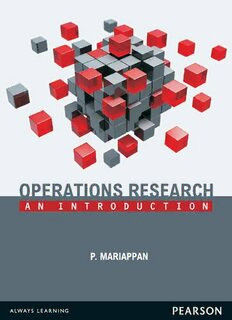Table Of ContentOPERATIONS
RESEARCH
AN INTRODUCTION
P. Mariappan
Department of Mathematics
Bishop Heber College
Tiruchirappalli, Tamil Nadu
Copyright © 2013 Dorling Kindersley (India) Pvt. Ltd.
Licensees of Pearson Education in South Asia
No part of this eBook may be used or reproduced in any manner whatsoever without the publisher’s
prior written consent.
This eBook may or may not include all assets that were part of the print version. The publisher
reserves the right to remove any material in this eBook at any time.
ISBN 9788131799345
eISBN 9789332517806
Head Office: A-8(A), Sector 62, Knowledge Boulevard, 7th Floor, NOIDA 201 309, India
Registered Office: 11 Local Shopping Centre, Panchsheel Park, New Delhi 110 017, India
I am dedicating this book to my beloved
Sister Mrs M. Krishnakumari,
Brother-in-law Mr O. Ravichandran,
and Mr O. R. Sivabalan
This page is intentionally left blank.
Contents
Foreword ix
Preface xi
About the Author xiii
1 Introduction 1
1.1 The History of Operations Research 1
1.2 The Meaning of Operations Research 1
1.3 Models of Operations Research 2
1.4 Scope of Operations Research 2
1.5 Phases of OR 4
1.6 Limitations of Operations Research 4
Exercise Problems 5
Review Questions 5
2 Linear Programming Problem (LPP) 6
2.1 Introduction 6
2.2 General Model of the Linear Programming Problem 6
2.3 Characteristics of an LPP 7
2.4 Assumptions of Linear Programming 7
2.5 Formulation of an LPP 8
2.6 Standard Form of an LPP 27
2.7 Solution to an LPP 29
2.8 Types of Possible Solutions to an LPP 30
2.9 Convex Set and Extreme Point 34
2.10 Graphical Solution to an LPP 35
2.11 Simplex Methods 48
2.12 Penalty Method/Big-M Method/Charnes Method 58
2.13 Two-phase Method 64
2.14 The Duality Concept in a Linear Programming 70
2.15 Dual Simplex Method (DSM) 76
2.16 The Revised Simplex Method (RSM) 82
Exercise Problems 96
Answers to the Exercise Problems 106
Review Questions 111
vi Contents
3 Sensitivity Analysis (or) Post-Optimal Analysis 116
3.1 Introduction 116
3.2 Change in the Objective Function Co-effi cient of a Non-basic Variable 116
3.3 Change in the Objective Function Co-effi cient of a Basic Variable 117
3.4 Change in the Right-hand Side of a Constraint 118
3.5 Change in the Column of a Non-basic Variable 120
3.6 Adding a New Constraint 121
3.7 Adding a New Variable 121
Exercise Problems 125
Answers to the Exercise Problems 126
Review Questions 126
4 Transportation Problem 128
4.1 Introduction 128
4.2 Conversion of a TP into an Equivalent LPP Form 129
4.3 Formulation of a Transportation Problem 130
4.4 Concepts of Feasibility Basicness, and Degeneracy in the Solution 130
4.5 Methods Used to Find the Solution to a Transportation Problem 131
4.6 Description of Various Methods to Find the Initial Basic Feasible Solution 133
4.7 Stepping Stone Method/Modifi ed Distributive Method 149
4.8 Transshipment Problems 171
4.9 Sensitivity Analysis for Transportation Problem 173
Exercise Problems 176
Answers to the Exercise Problems 182
Review Questions 183
5 Assignment Problem 186
5.1 Introduction 186
5.2 General Model of the Assignment Problem 186
5.3 Conversion into an Equivalent LPP 186
5.4 Solution to the Assignment Problem 187
5.5 Travelling Salesman Problem 199
Exercise Problems 203
Answers to the Exercise Problems 209
Review Questions 211
6 PERT - CPM 213
6.1 Introduction 213
6.2 Method for Construction of a Network 214
6.3 Numbering the Nodes 215
6.4 Critical Path Method (CPM) 218
Contents vii
6.5 Project Evaluation Review Technique (PERT) 227
6.6 PERT-Cost 234
6.7 Resource Levelling 239
Exercise Problems 242
Answers to the Exercise Problems 249
Review Questions 251
7 Sequencing 253
7.1 Introduction 253
7.2 Johnson’s Method (Rule) 253
7.3 Graphical Method 263
Exercise Problems 265
Answers to the Exercise Problems 268
Review Questions 268
8 Queuing Theory 269
8.1 Introduction 269
8.2 Some Queuing Terminologies 269
8.3 Model : 1 Single Server Model with Infi nite Queue (M/M/1): (∞/FCFS) 272
8.4 Model : 2 Single Server Model with Finite Queue (M/M/1): (N/FCFS) 291
8.5 Model : 3 Multi-server Model with Infi nite Queue (M/M/C): (∞/FCFS) 297
8.6 Model : 4 Multi-server Model with Finite Queue (M/M/C): (N/FCFS) 301
Exercise Problems 302
Answers to the Exercise Problems 306
Review Questions 307
9 Dynamic Programming 309
9.1 Introduction 309
9.2 Calculus Method to Solve a DPP 312
9.3 Tabular Method to Solve a DPP 319
9.4 DPP Application to Solve an LPP 332
Exercise Problems 335
Answers to the Exercise Problems 338
Review Questions 339
10 Non-Linear Programming 341
10.1 Introduction 341
10.2 General Structure of an NLPP 341
10.3 Formulation of an NLPP 342
10.4 Methods to Solve an NLPP 343
10.5 Constrained Optimization with Inequality Constraints 350
viii Contents
10.6 Quadratic Programming Problem (QPP) 356
10.7 Wolfe’s Method to Solve a QPP 356
10.8 Beals Method to Solve a QPP 365
Exercise Problems 370
Answers to the Exercise Problems 372
Review Questions 372
Appendix A 374
Appendix B 376
Index 377
Foreword
Operations Research - An Introduction, written by Dr P. Mariappan, takes into account the whole gamut
of undergraduate, postgraduate and professional courses that will require a good knowledge of opera-
tions research. It has a singular merit of catering to the requirements of students of introductory as well
as advanced level courses.
The contents have been arranged on the principle of gradation. The ten chapters of the book are
arranged in a logical sequence of Introduction, Linear Programming Problems and so on, before the
concept of Dynamic Programming is discussed at the end.
There are two distinctive features that make the book stand apart—fi rst, it is based on the self-taught
learning method and second, the book has an exclusive section on examples and exercises related to the
standard problems. I am sure the book will be very useful to the teaching and the student community.
I congratulate Dr Mariappan for the service he has rendered to the student community.
Dr E. C. Henry Amirtharaj
Dean for Training and Placement Division
and
Associate Professor of Mathematics
Bishop Heber College
Tiruchirappalli
Tamil Nadu

